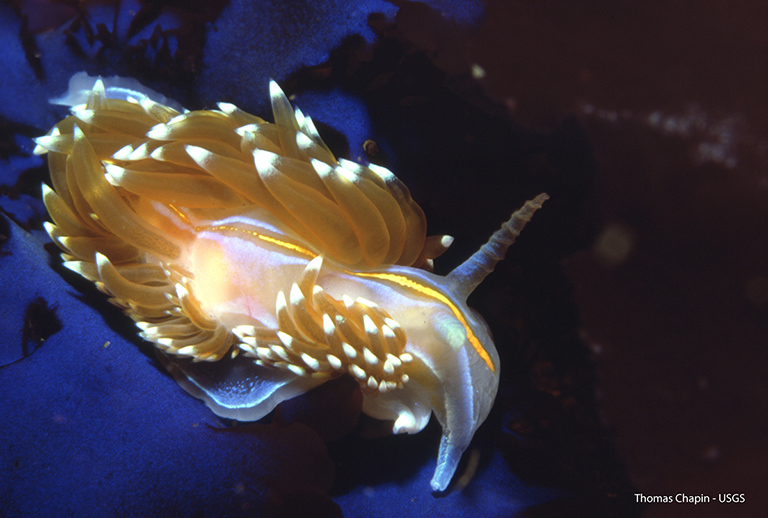Ask NASA Climate | June 20, 2016, 03:15 PDT
A sea slug changed my life

This underwater photo of a sea slug was captured with a close-up lens in Monterrey, Calif., by my first SCUBA instructor, Thomas Chapin circa 1985.
At 8 p.m. after a long day of work in the Houston humidity, Derek Rutavic, manager of the NASA Gulfstream-III that will head back to Greenland this fall, and I were in the back of the plane singing One Direction’s "Drag Me Down" over the high frequency radio system. It was stifling hot, getting dark and we were tired and hungry.
But Oceans Melting Greenland (OMG) Principal Investigator Josh Willis and Project Manager Steve Dinardo, too busy to take off their sweaty fire retardant flight suits, were troubleshooting electronics at two racks of computers, and they’d asked Rutavic to get on the headset to find out if the headset noise was interfering with the high radio frequency data signal the ocean science probes were sending back to the plane. Rutavic sat on an empty science probe container, while I lounged on one of the sofas singing along in awe of the amount of hard work this team was putting in.
We’d been up early, flown multiple test flights, worked through lunch. And all of this after days and days of maintenance, and weather delays, and more hard work after more hard work. Earlier in the day, NASA T-38 supersonic jet pilot Bill Rieke flew mind-bogglingly close to the G-III to photograph the science probe deployment and determine if the technique of launching the probes through a hole in the bottom of the plane would succeed. And yes, it did. But that success merely signaled the OMG team to continue working.
And I understood exactly why this team kept going, kept moving, kept pushing on into the evening, regardless of being tired and hot and hungry. I knew exactly why they decided to keep working on the challenge. They chose to push through because they’d found something to care about, and that's always more important than our difficulties and problems. When we focus on what we really care about, we get busy doing something, even in the face of trouble. And that’s how science works.
Lessons from a sea slug
I first learned to care about the natural world around me during my junior year in college. I was in an oceanography course and we were studying sea slugs. (Yes, sea slugs.) A sea slug changed my life. Before then, I’d been, like many people, disengaged and uninterested in science. In third grade, someone came to our classroom and told us we could be the first female astronaut, and I remember thinking, “No, I couldn’t, not me.”
And now? Even though I have a job at NASA, I still feel like I don’t belong in the world of science. I feel more comfortable around athletes and artists than I do with a bunch of Ph.D.s. Maybe it’s some poorly defined stereotype that I’ve somehow bought into or some preconceived notion of how someone who does science is supposed to behave.
But those sea slugs taught me that I cared more about the natural world than I cared about the struggle of not fitting in or the challenge of the work. They appeared so delicate, small and defenseless, and I identified with that. They helped me feel connected. Noticing them forced me to wonder what else I’d start to notice if I slowed down enough to pay attention. And that connection to the natural world helped me stay committed to science, even when it was hard, even when there were problems, even when I felt like running away.
Sure, scientific experimentation, just like much of real life, includes problems, troubles, obstacles and difficulties almost every day. And while it’s true that someone, somewhere has to troubleshoot something every step of the way, we can also be excited about the effort. The OMG team understands that problems and hard work are not the exception, they are the norm. They are part of accomplishment. And it’s totally possible to thrive on these difficulties and challenges.
Look, we could be setting the world on fire right now, not by burning fossil fuels, but by our burning desire to understand our environment. Because the whole point of this experimental mission is to find out how quickly the warmer waters around Greenland are melting the second-largest ice sheet on the planet. It’s major; it’s dire; it’s intense. It’s one of the most important issues of our time.
And sitting there in the back of that plane made me think about how we, as individuals and as a society, have to find something in this world to care about. We have to find something in this world that is more important than our challenges and problems.
And you? I hope you decide to find something to care about. I hope you find something that’s important enough that you’re willing to push through your struggles, your fears and your problems to just do the work.
Find out more about Oceans Melting Greenland.
View and download OMG animations and graphics.
Thank you,
Laura
Oceans Melting Greenland is part of NASA Earth Expeditions, a six-month field research campaign to study regions of critical change around the world.
